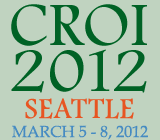
 A new formulation of the nucleotide reverse transcriptase inhibitor (NRTI) tenofovir, currently dubbed GS 7340, achieves superior efficacy along with far higher concentrations inside the cells targeted by HIV for infection, compared with the current version of tenofovir (found in Viread, Truvada and Atripla). These data, which were presented Wednesday, March 7, at the 19th Conference on Retroviruses and Opportunistic Infections (CROI) in Seattle, suggest that the drug may be an excellent candidate for fixed-dose combination tablets.
A new formulation of the nucleotide reverse transcriptase inhibitor (NRTI) tenofovir, currently dubbed GS 7340, achieves superior efficacy along with far higher concentrations inside the cells targeted by HIV for infection, compared with the current version of tenofovir (found in Viread, Truvada and Atripla). These data, which were presented Wednesday, March 7, at the 19th Conference on Retroviruses and Opportunistic Infections (CROI) in Seattle, suggest that the drug may be an excellent candidate for fixed-dose combination tablets.
GS 7340 is a “prodrug” of tenofovir. Prodrugs are typically inactive chemical compounds that turn into an active drug when they interact with the body’s metabolic system. GS 7340’s mechanism of action is the same as tenofovir, but it requires a dose that is 10 times lower than Viread and it works better.
Tenofovir is a potent antiretroviral drug that in its base form is not well absorbed into the blood stream and is quickly eliminated from blood. To overcome this problem, Gilead Sciences made Viread, a prodrug version of tenofovir.
Viread allows for slower elimination of the tenofovir, because it takes a while for the body to transform Viread into tenofovir. That way it can reach and maintain adequate blood levels of the active drug. Unfortunately, boosting the amount of drug in the blood can also increase the amount that gets into the kidneys, which can lead to a potentially worrisome side effect—damage to the tubules that help the kidneys filter blood. In fact, in a separate presentation at CROI, researchers in the Netherlands confirmed that high blood levels of tenofovir are directly related to the risk of kidney tubular dysfunction and lingering kidney disease.
In an attempt to overcome this problem, and to increase the potency of the drug, Gilead experimented with stripping away the additional molecules present in Viread. In their place, the company added other molecules—thereby creating a new prodrug—that result in substantial increases of tenofovir inside the cells targeted by HIV, such as CD4 cells, but not in the blood or in organs such as the kidneys. This was accomplished by building a new chemical chain that doesn’t turn into tenofovir until it is transformed by cathepsin A2, which is produced predominately by a white blood cell called a lymphocyte. The end result was GS 7340.
Though Gilead announced in 2004 that it had no interest in further developing the drug, arguing that it “does not believe that GS 7340 has a profile that differentiates it to an extent that supports its continued development,” the company ended up reconsidering the drug’s potential in recent years. In fact, Gilead is partnering with Janssen Therapeutics to develop a combination tablet containing cobicistat-boosted Prezista (darunavir) plus GS 7340 and Emtriva (emtricitabine). Gilead is also replacing Viread with GS 7340 in a newer formulation of its Quad fixed-dose combination tablet containing the integrase inhibitor elvitegravir, the boosting agent cobicistat and Emtriva.
Presented at last year’s CROI in Boston, results of a 14-day study found that while GS 7340 resulted in intracellular levels of tenofovir that ranged from 4 to 33 times higher than Viread, it accomplished this with less than half the amount circulating in the blood.
As a follow-up, Peter Ruane, MD, and his colleagues randomized 38 people living with HIV to receive one of three doses of GS 7340—8, 25 or 40 milligrams (mg)—or open-label Viread (300 mg) or placebo for 10 days. All volunteers had viral loads in excess of 2,000 copies and didn’t have any evidence of drug resistance mutations upon entering the study. Most subjects were males, averaging 38 years old, with nearly 450 CD4 cells.
At day 11 of the study, viral load decreases averaged 0.97 log among those who took Viread and 0.07 among those who took placebo. Conversely, viral loads were 1.08 log below pre-treatment levels in the 8 mg GS 7340 group, 1.46 log below pre-treatment levels in the 25 mg group and 1.73 log below pre-treatment levels in the 40 mg group. The differences between those in the two highest GS 7340 dosing groups, compared with those receiving either Viread or placebo, were statistically significant.
Ruane and his colleagues also reported marked differences in blood and cellular concentrations between those receiving GS 7340 and those in the control group. Compared with tenofovir blood levels among those receiving Viread in the study, volunteers receiving GS 7340 had average and peak blood concentrations that were 79 percent to 98 percent lower, respectively. Cellular concentrations of tenofovir, compared with those receiving Viread in the study, were up to 20 times higher among those receiving 40 mg GS 7340.
No subject discontinued the study drug during the 10-day trial. Ruane’s team also noted that there were no clinically significant laboratory abnormalities or serious drug-related side effects.
“GS 7340 25 mg and 40 mg demonstrated superior antiviral efficacy to [300 mg Viread], achieving higher intracellular [tenofovir] concentrations with lower systemic [tenofovir] exposure,” the researchers concluded. “GS 7340 has the potential to be more efficacious with an improved safety margin, and to be easier to co-formulate, compared with [Viread].”






7 Comments
7 Comments